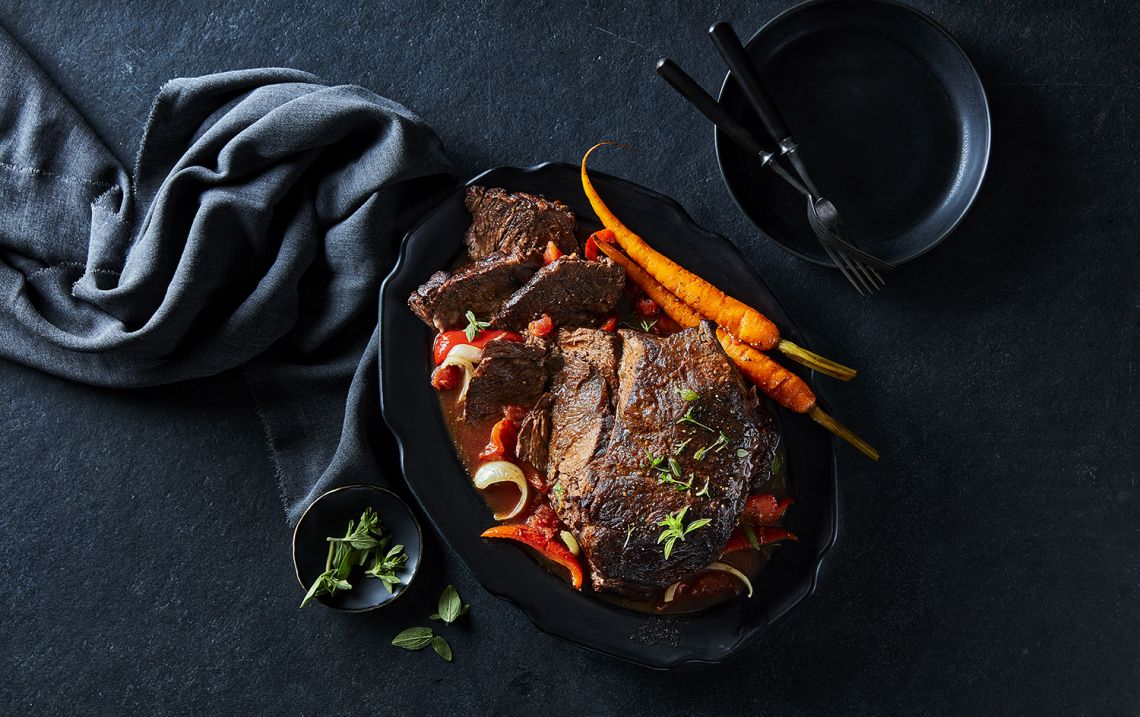Cooking a beef roast in the oven requires minimal attention and effort to achieve delicious results! To make sure you have the best tips in hand, Sterling Silver® experts have broken down the basics so you can build on your arsenal of tips and tricks to make sure your favourite cuts - from sirloin tip oven roast to beef blade roast and more - are all cooked to perfection.
Oven-roasting, explained
Oven roasting is a slow-cooking process that uses hot, dry air to cook food in the oven at higher temperatures and is commonly used for meats and vegetables. What makes it different from baking? It's the temperature. Roasting uses higher temperatures: the typical oven setting for roasting beef is 204oC (400oF) or higher. (The higher temperatures help to brown the meat's surface and develop the flavour over time.)
What's the difference between roasting and baking?
The roasting method allows thicker, tougher foods to brown and crisp, while baking retains moisture in thinner, more delicate foods. Note: It primarily comes down to the oven's temperature setting as the average oven won't offer both settings (and they're essentially the same, anyway).
What's the ideal roast beef oven temperature?
The ideal temperature setting changes depending on the beef product that you are roasting. Always use a food thermometer to assure that the meat has reached a safe minimum internal temperature. When roasting meat, it is recommended to set the oven temperature to 165oC (325oF) or higher.
Oven roasting tools
There are a variety of options, but the basics are a roasting pan and an inset rack (a nice-to-have). The meat can also be rotated on a spit or rotisserie.
Tip: If a pan is used, keep the juices for gravy or au jus sauce.

How to cook roast beef
- Remove the roast from its package and place on a platter, uncovered, in the fridge overnight. This helps dry the roast, and promotes a better browning process. Make sure to place raw meat below any ready to eat and cooked items to ensure food safety with other items in your refrigerator.
- One hour prior to cooking, remove roast from fridge. Allowing it to come closer to room temperature assists with properly roasting the meat (a cold roast going into a hot oven will not cook evenly).
- Season with Kosher salt and black pepper prior to cooking. Approximately 1 tsp. of Kosher per lb. of roast and half the amount of black pepper.
- Preheat oven to 190oC (375oF). While oven is preheating, place in a roasting pan with an inset rack, fat side up.
- Cook until roast reaches desired doneness. Below cooking times are for reference only, you should always refer to a meat thermometer to ensure the beef reaches the desired doneness.
- Use a meat thermometer to check the internal temperature of the roast and always check in the thickest part of the roast.
- Rib roast will cook for approximately 2 hours for medium rare
- Strip roast will cook for approximately 1.25 hours for medium rare
- Tenderloin roasts will cook for approximately 40 minutes for medium rare doneness
Tips and tricks
- Always use oven meat thermometers
Using an ovenproof meat thermometer that stays in the roast during the cooking process is preferable. This helps you avoid the need to open the oven (releasing heat) or poking multiple holes in the roast (releasing delicious juices). - Carry over cooking
Carry over cooking is when meat cuts continue to cook after you take them out of the oven. When targeting a specific cook temperature, it's a good idea to cook the product approximately 5 to 10 degrees below desired temperature to achieve your desired doneness via carry over cooking (and avoid overcooking the roast!). - Resting time
Allow the roast to rest prior to slicing. Resting the meat allows the juices to move from the surface of the roast to redistribute throughout the roast. To rest, tent with aluminum foil and let rest for a minimum of 30 minutes. - Pan sauce
Utilize pan drippings to create a pan sauce or au jus. Skim as much fat as you can from the roasting pan, then place the pan on the stove top. Add water or beef broth to the pan, and scrape to gather the tasty bits. Continue to cook until liquid is reduced by half. Season with salt and pepper to taste. Serve in small side dish for dipping. - Roast vegetables For a large roast, instead of placing the beef on a metal rack, peel and cut onions in half and place the seasoned roast on the cut onions (onions replace the rack). At the end of the roasting process, the onions are soft, caramelized, and delicious.
